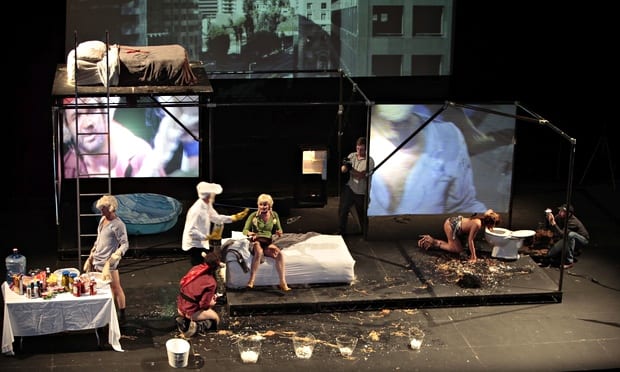As the show of WOMENSwear develops, it is becoming much clearer that certain aspects of our set design do not work as well as we initially expected. Trying to source both hay bales and a tin bath for a suitable fee is proving difficult, this has lead to a rethinking of what we should do to make the show both sustainable, but also aesthetically pleasing. As designer of the set, I went back to our original images that influenced us and analysed why they did.
(Summerhall, 2014)
It became apparent to me that the reason I enjoyed the aesthetics of Looking for Paul were there use of levels. It became hard for us as a company to justify why we were using a tin bath and hay bales, therefore we collectively decided that they would have to go. The set then stood with a large scaffolding at stage right, and a small rostra at stage left. The use of levels in Looking for Paul, really made me re-think why they worked so well for our performance. For me the need for levels came down to a level of understanding for our audience.
The feedback we ascertained from our show backs during the module, made us realise just how difficult it was for an audience to relate to the stories of the international women, as they have never experienced having to fear to go to school for example. This made me realise that the placing of our stories needed to be shown onstage. By placing the international stories on the high platform, it gave an element of distance from the audience, they were further away, therefore they were less familiar. This was coupled with the use of lighting, both cross over lights at the large platform never lit the face. Taking away the element of being able to see the performers eyes, it took away the familiarity of the scene, the performers where no longer us, they were unfamiliar, someone else. This was enforced even further by using the cold light at the microphone and music stand, and the warm light at the mattress, to provide a sense of familiarity, the bedroom set-up, and the unfamiliar, they story.
“Levels of considerable height introduce greater divisions, they naturally suggest a greater distance therein increasing the dynamics. This may be to emphasize power and control. The use of platforms, steps and ramps adds interest and variety.” (Thorne, 1999, Chapter 11).
By using levels we have emphasised the difference in familiarity, the platforms closer to the floor are more familiar, the platforms further away are less familiar. The whole set design is intended to speak as a character of it’s own, it adds another dimension to the performance, just like how the levels add dimension to the set design.
The stories written by us that were still verbatim, were placed on the small rostra, therefore letting the audience feel that the stories were more related to them, however the element of height still gave the understanding that these were not their stories, but that they belonged to someone else. This again was coupled with the use of lighting, the introduction of face light on the performer made the story more familiar, giving the audience more room to relate to the performer, as they could see all of them clearly and well defined.
The final stand alone platform featured just a single face light, giving the mic and music stand an almost stand up comedy feel. The use of levels put the performer closer to the audience providing a sense of familiarity, the use of the “we…” lines added to this effect, as we were not longer talking from our perspective, or another persons perspective, but instead a generalised perspective. The lines are more relatable each audience member could pick out a few lines that related to them, which links back to the idea of the stand up comedy mic, as this is how a great majority of stand up works, they make the audience relate to what they are talking about, but they make them see how ridiculous/ funny it is. This type of comedy is best described as observational comedy. It provides the reasons as to why the end lines of our performance are some of the funniest lines in the play. “A more familiar kind of sharing is observational comedy in which the comedian talks about everyday phenomena that are rarely noticed or discussed…Your observations need to be something people can relate to, for the audience to pick up on it.” (Double, 2005, 116).
Work Cited
Double, O. (2005) Getting the Joke: The Art of Stand-up Comedy. Meuthen Drama: London.
Summerhall. (2014) Looking for Paul – Wunderbaum. [online] Edinburgh: Summerhall. Available from http://festival14.summerhall.co.uk/event/looking-for-paul-wunderbaum/ [Accessed 30 March 2015].
Thorne, G. (1999) Stage Design: A practical guide. Crowood: Wiltshire.
